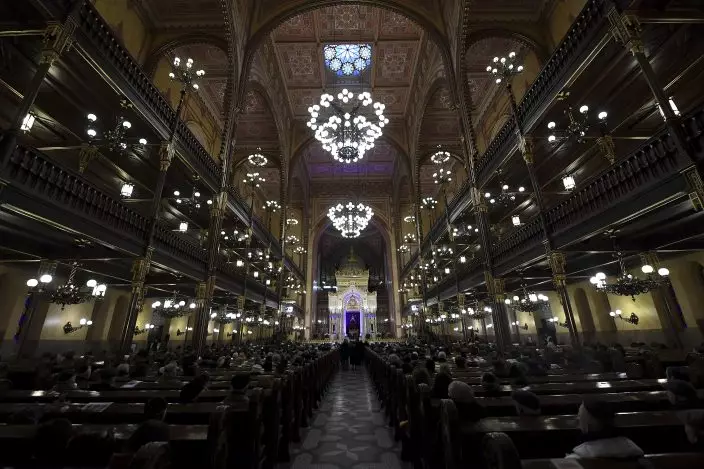Hungary's Jewish community on Sunday commemorated the 75th anniversary of the liberation by Soviet troops of the Budapest ghetto, where over 70,000 Jews were confined near the end of World War II.
While some 550,000 Hungarian Jews were killed during the Holocaust in Nazi-run death camps, in forced labor battalions or by the Nazis' Hungarian allies, many Budapest Jews survived the war. They went into hiding in the ghetto or were helped by sympathetic foreign diplomats like Sweden's Raoul Wallenberg.
Hundreds of people attended the commemoration at Budapest's Dohany Street Synagogue, the largest in Europe, including Holocaust survivors, diplomats and politicians.

People attend a ceremony that commemorates the 75th anniversary of the liberation of the Budapest Jewish ghetto in Dohany Street Synagogue in Budapest, Hungary, Sunday, Jan. 19, 2020. The ghetto was liberated by the Soviet Red Army during World War II on January 17, 1945. (Tibor IllyesMTI via AP)
Robert Frolich, the synagogue's chief rabbi, spoke of “ambivalent feelings” surrounding the commemoration, which contains pain and mourning, but also the “celebration of life.”
“Seventy-five years ago, Europe’s last ghetto, the Budapest ghetto, was liberated. This is what we remember today,” Frolich said. “Ambivalent feelings gather inside us, because the reason for the event, the liberation of the ghetto, is itself ambivalent.”
“It contains pain, it contains tragedy and the mourning which cannot be put into words, which is unspeakable and can only be experienced. At the same time, it contains joy, relief and the celebration of life.”
Jews were forced to move into the ghetto, set up over more than 20 city blocks in Budapest's traditional Jewish quarter, from the end of November 1944.
Enclosed with wooden planks and brick walls, conditions in the ghetto during the cold winter were inhumane. Residents faced mass starvation and disease. Thousands of dead bodies had to be lined up at a square after the ghetto's designated burial areas were full.
According to historians, by the end of 1945 the deaths of some 14,000 people could be attributed to the conditions in the Budapest ghetto — either those who died there or those who became sick there and passed away in the months following its liberation on Jan. 18, 1945.
Most of the Hungarian Jews killed during the Holocaust, which numbered some 420,000 people, were residents of countryside cities and villages. They were deported from their homes by rail to Auschwitz and other Nazi death camps in less than two months in mid-1944.


